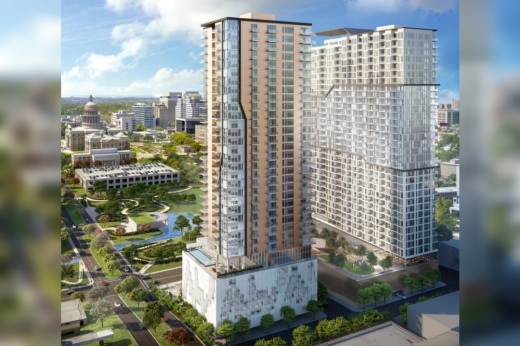The lead-up to the transformation of city-owned land on the eastern edge of downtown has stretched on for years after the city acquired the former health care facility and parking garage in 2017. An initial outline of the project's scope was presented in May 2021, and since then Austin and its chosen developer Aspen Heights Partners have continued to negotiate around that plan.
City leaders have aimed to bring hundreds of affordable apartments and several publicly accessible spaces such as a music venue and child care center to the site. They are set to vote Sept. 29 on a master development agreement with Aspen Heights to be finalized in the coming months.
Aspen Heights' proposal now centers on a pair of 37-story high-rises at 1215 Red River St. and 606 E. 12th St., which are owned by the city. The project footprint expanded this April after Aspen Heights moved to purchase the Texas FFA Association building next door at 614 E. 12th St., allowing the developer to upgrade its proposal to include 80% more residences while eliminating office use on the nearly 2-acre site. The two towers would be connected by a 30,000-square-foot plaza accessible to the public.
Between the north and south towers, the development is now planned at 921 apartments, and the portion of those spaces to be available for residents with lower incomes was recently increased.
Council is now considering final project terms that call for Aspen Heights to set aside 232 income-restricted units ranging from studio to three-bedroom spaces—more than 25% of the project's overall total—located entirely in the southern tower. Of those affordable units, 117 would be available to renters earning less than 50% of the local median family income, or MFI, while 115 would be available to those earning 60% of the MFI and below. The Austin area's MFI is $110,300 for a family of four.
Susana Carbajal, deputy director of the Austin Economic Development Department, said Sept. 27 that both towers would be built on the same timeline with units expected to open as soon as the summer of 2027.
Finalizing details
When council last discussed the project and ongoing negotiations in July, officials debated over reducing the amount of Aspen Heights' lease to the city to build more affordable spaces. The 232 units now proposed double the developer's original plans, and the term sheet up for council approval this week notes that increase was made possible by the city reducing its required lease payment more than 40% from $21 million to $12.2 million.
Alongside the affordable housing, Aspen Heights and the city are also eyeing several other community spaces and amenities throughout the project that would be open to the public. Those include 35,160 square feet of commercial space with some available at an affordable rate to local retailers, the public plaza, an 11,840-square-foot affordable child care center, a 7,400-square-foot live music venue, financial support for a new roadway connecting Red River and Sabine streets, and hundreds of public parking spaces.
Amanda Swor, a lobbyist representing Aspen Heights, said in July that the developer's slate of community benefits totaled more than $50 million and that the project overall would generate about $13 million in annual tax revenue.
Council voted 6-4-1 in July to allow Aspen Heights and city housing staff to continue negotiations over the proposal until a Sept. 30 deadline. That extension also came with direction for staff to determine if the housing and community benefits package was possible and to weigh different options in the tradeoff of the lease payment for affordable housing.
With that deadline approaching, council members appear satisfied with the results of the extra two months of negotiations and ready to approve moving the development agreement forward Sept. 29. District 3 Council Member Pio Renteria credited the "amazing work" that led to the final outline, and District 9 Council Member Kathie Tovo—who voted against the extension in July in favor of rebooting the negotiating process—said in a message board post that she was excited by the proposal while noting some remaining room for improvement.
District 1 Council Member Natasha Harper-Madison said she supports the plan given Austin's need for affordable housing and as another piece of ongoing improvements in eastern downtown.
"It’s important to remember the history of this area and how we completely liquidated an entire community of largely Black and brown residents in the name of 'urban renewal'—another conversation that’s ongoing for us. For the sake of so-called slum clearance, we created a crater, frankly, in northeastern downtown that stood largely lifeless for decades," she said. "With the new teaching hospital and the reincarnation of the Waterloo Park we’ve been slowly revitalizing the area for a few years now, but this project promises to put that work into overdrive.”





